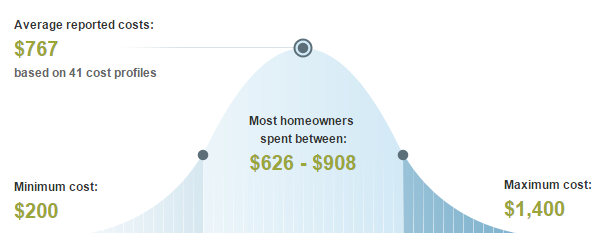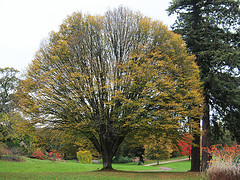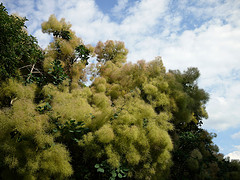Skip to a section:
How Much Do Tree Services Cost in Ann Arbor?
Named for Bur Oak trees, Ann Arbor is the sixth-largest city in Michigan as well as a beautiful, green destination. Although many local residents tackle much of their yard maintenance and gardening solo, hiring professionals for bigger jobs may be the best course of action. This guide can help provide information about costs of some of the more popular tree services in Ann Arbor.

How Much Does Tree Removal Cost?
The average cost of tree removal in Ann Arbor is $770, which is slightly above the national average. The price will vary according to the height of the tree, the surrounding terrain and the time of year. Living trees that need to be felled and removed may cost upwards of $900, but a dead tree that simply needs to be hauled off the property could be as low as $630.
How Much Does Stump Removal Cost?
Tree stumps may need to be removed in order to increase the attractiveness of the yard, but their removal can also make the area safer. On average, residents in Ann Arbor can expect to pay between $85 and $155 to have a stump ground down. This should include the entire root system as well as hauling away the sawdust and debris created by the grinding process.
Average Cost of Tree Maintenance in Ann Arbor
The exact cost of tree trimming and pruning in Ann Arbor will depend on the height of the trees, the number of trees that need attention and the overall difficulty of the job. Although exact numbers can vary substantially, residents in the area can expect to pay anywhere between $140 and $170 for a professional job taking roughly three to five hours.
Ann Arbor Tree Facts & FAQs
Nicknamed Tree Town, Ann Arbor truly is a tree-filled destination. Since the founding of this Michigan city in 1824, trees have played a pivotal role in its history. Part of the appeal of the area had to do with the bountiful natural resources, which were used in the early construction of the city. In fact, the native Chippewa tribes in the area referred to Ann Arbor as kaw-goosh-kaw-nick, imitating the sound of the first sawmills used for timber. Estimates for the total number of trees in Ann Arbor are well over 100,000, with half being located in public parks and the other half lining the city’s streets. Residents are eager to keep their city looking beautiful, and this guide can detail some of the tips and suggestions for tree planing and maintenance.
Tree Service Tips and Regulations
Trees growing in the right-of-way, or the area between the sidewalk and the curb, are not allowed to be removed as they are under city jurisdiction and care. However, if they need trimming or care, and homeowners would like to provide that, they are more than welcome pending a permit approval from the Ann Arbor Forestry Service Unit. For trees standing on residential property, there are no restrictions on what can be grown or removed. The exception to this is historic properties that fall under Michigan’s Local Historic District Act. Owners of historic homes and properties may need the Historic Preservation department to walk through the property and agree to any changes before they begin.
It is also important to note that DTE, the primary energy provider in Ann Arbor, maintains the trees that could potentially become a problem for existing overhead power lines. If line clearance is a problem, DTE employees may trim private trees as needed without warning.
Common Trees
 Pinus strobus, more commonly known as white pine, is the state tree of Michigan. Native to North America, it is especially common throughout the Great Lakes region. The official designation of the white pine as Michigan’s state tree came in 1955.
Pinus strobus, more commonly known as white pine, is the state tree of Michigan. Native to North America, it is especially common throughout the Great Lakes region. The official designation of the white pine as Michigan’s state tree came in 1955.
The trees that will do best in Ann Arbor tend to be those that are native to the area or require minimal maintenance in order to thrive. Ann Arbor’s climate is classed as humid continental, which means that there are four seasons, roughly 50 to 60 inches of snowfall each winter and warm, humid summers. The following trees are some of the best choices to handle the severity of winter:

- Dogwood (Cornus)
- Hornbeam (Carpinus)
- Bur oak (Quercus macrocarpa)
- Tulip tree (Liriodendron)
- Striped maple (Acer pensylvanicum)
- Eastern redbud (Cercis canadensis)
- American smoketree (Cotinus)
- Downy serviceberry (Amelanchier arborea ‘Trazam’)
Not all trees can handle the snow and months of freezing temperatures that Ann Arbor is prone to each year. However, there are some fruit trees that thrive in the area. Residents who want to have fruit on their property might gravitate toward Bosc pears, pawpaw and cherries.
Tallest and Shortest Trees in Ann Arbor
Trees in Ann Arbor come in many different shapes and sizes. To find some of the tallest trees in the city, head to Wurster Park. It is there that a Chinkapin oak stands, towering over the other trees in the park. The oak is determined to be more than 150 years old, and is one of the tallest in the state. On Ferdon Street is another tall tree: a 109-year-old pignut hickory. For the smallest trees, look for dwarf fruit trees or bonsai trees, many of which can be found in local nurseries.
Common Tree Diseases
Unfortunately, many of the trees in Ann Arbor are susceptible to pests and tree diseases. The most common is the emerald ash borer, which is a major problem in the region. Other common diseases include maple chlorosis, apple scab, leaf gall and evergreen needle shed.
Plant Hardiness Zones in Michigan
Here is the Michigan plant hardiness zone map, as provided by the USDA:

Image credits:
Hornbeam
Common smoketree
Local Tree Services in Ann Arbor
